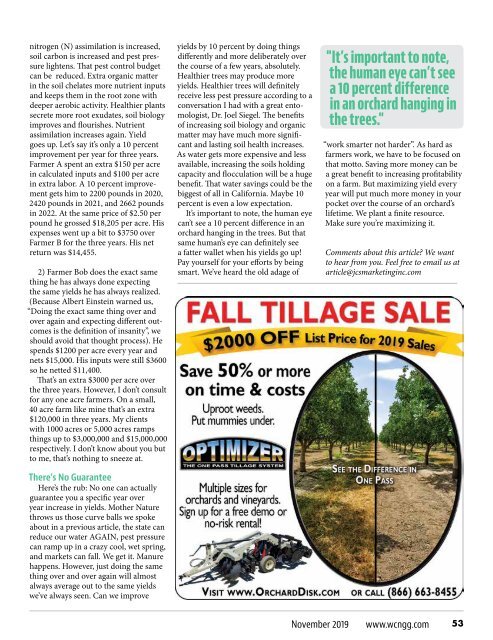Create successful ePaper yourself
Turn your PDF publications into a flip-book with our unique Google optimized e-Paper software.
nitrogen (N) assimilation is increased,<br />
soil carbon is increased and pest pressure<br />
lightens. That pest control budget<br />
can be reduced. Extra organic matter<br />
in the soil chelates more nutrient inputs<br />
and keeps them in the root zone with<br />
deeper aerobic activity. Healthier plants<br />
secrete more root exudates, soil biology<br />
improves and flourishes. Nutrient<br />
assimilation increases again. Yield<br />
goes up. Let’s say it’s only a 10 percent<br />
improvement per year for three years.<br />
Farmer A spent an extra $150 per acre<br />
in calculated inputs and $100 per acre<br />
in extra labor. A 10 percent improvement<br />
gets him to 2200 pounds in 2020,<br />
2420 pounds in 2021, and 2662 pounds<br />
in 2022. At the same price of $2.50 per<br />
pound he grossed $18,205 per acre. His<br />
expenses went up a bit to $3750 over<br />
Farmer B for the three years. His net<br />
return was $14,455.<br />
2) Farmer Bob does the exact same<br />
thing he has always done expecting<br />
the same yields he has always realized.<br />
(Because Albert Einstein warned us,<br />
“Doing the exact same thing over and<br />
over again and expecting different outcomes<br />
is the definition of insanity”, we<br />
should avoid that thought process). He<br />
spends $1200 per acre every year and<br />
nets $15,000. His inputs were still $3600<br />
so he netted $11,400.<br />
That’s an extra $3000 per acre over<br />
the three years. However, I don’t consult<br />
for any one acre farmers. On a small,<br />
40 acre farm like mine that’s an extra<br />
$120,000 in three years. My clients<br />
with 1000 acres or 5,000 acres ramps<br />
things up to $3,000,000 and $15,000,000<br />
respectively. I don’t know about you but<br />
to me, that’s nothing to sneeze at.<br />
There’s No Guarantee<br />
Here’s the rub: No one can actually<br />
guarantee you a specific year over<br />
year increase in yields. Mother Nature<br />
throws us those curve balls we spoke<br />
about in a previous article, the state can<br />
reduce our water AGAIN, pest pressure<br />
can ramp up in a crazy cool, wet spring,<br />
and markets can fall. We get it. Manure<br />
happens. However, just doing the same<br />
thing over and over again will almost<br />
always average out to the same yields<br />
we’ve always seen. Can we improve<br />
yields by 10 percent by doing things<br />
differently and more deliberately over<br />
the course of a few years, absolutely.<br />
Healthier trees may produce more<br />
yields. Healthier trees will definitely<br />
receive less pest pressure according to a<br />
conversation I had with a great entomologist,<br />
Dr. Joel Siegel. The benefits<br />
of increasing soil biology and organic<br />
matter may have much more significant<br />
and lasting soil health increases.<br />
As water gets more expensive and less<br />
available, increasing the soils holding<br />
capacity and flocculation will be a huge<br />
benefit. That water savings could be the<br />
biggest of all in California. Maybe 10<br />
percent is even a low expectation.<br />
It’s important to note, the human eye<br />
can’t see a 10 percent difference in an<br />
orchard hanging in the trees. But that<br />
same human’s eye can definitely see<br />
a fatter wallet when his yields go up!<br />
Pay yourself for your efforts by being<br />
smart. We’ve heard the old adage of<br />
"It’s important to note,<br />
the human eye can’t see<br />
a 10 percent difference<br />
in an orchard hanging in<br />
the trees."<br />
“work smarter not harder”. As hard as<br />
farmers work, we have to be focused on<br />
that motto. Saving more money can be<br />
a great benefit to increasing profitability<br />
on a farm. But maximizing yield every<br />
year will put much more money in your<br />
pocket over the course of an orchard’s<br />
lifetime. We plant a finite resource.<br />
Make sure you’re maximizing it.<br />
Comments about this article? We want<br />
to hear from you. Feel free to email us at<br />
article@jcsmarketinginc.com<br />
<strong>November</strong> <strong>2019</strong><br />
www.wcngg.com<br />
53


















